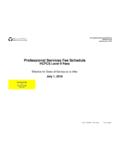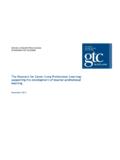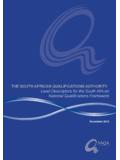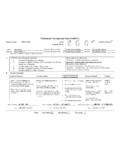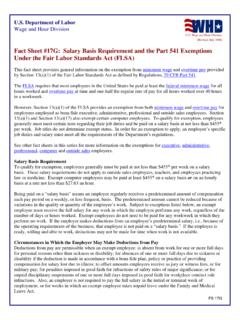Transcription of RevisedNovember 2009 - FLCDataCenter.com
1 Revised November 2009 Employment and Training Administration prevailing wage determination policy guidance Nonagricultural Immigration Programs Revised November 2009 The publication of the H 2B regulation in December 2008 and the corresponding changes to PERM, H 1B, H 1B1, H 1C and E 3 regulations governing temporary professional, non agricultural or registered nursing programs changed the roles of the SWAs and NPCs in the prevailing wage determination process and necessitated the issuance of policy and procedural guidance to be used by the National prevailing wage and Helpdesk Center (NPWHC). The H 2B regulation became effective on January 19, 2009. Pursuant to that Final Rule, the transition of the prevailing wage function from the State Workforce Agencies will be completed by December 31, 2009. As of January 1, 2010, the NPWHC will receive and make prevailing wage determinations for all non agricultural temporary and permanent programs.
2 The major changes affecting prevailing wage determinations that became effective as a result of the H 2B Final Rule include: 1. Federalizing PWDs. Employers will now file requests and obtain PWDs directly with NPWHC. 2. Use of standard prevailing wage Request Form 9141 for all non agricultural prevailing wage requests. The PERM regulation lists professional O*NET SOC occupations and their designated education and training categories. Those education and training categories shall be used when considering the education and training generally required for performance in that occupation (see Appendix D). This guidance has been divided into several sections for easy reference: I. policy guidance A. Background B. prevailing wage Factors II. Making Determinations A. wage Rates Covered by Collective Bargaining Agreements B. wage Determinations Using BLS OES wage Data 1.
3 OES wage Levels 2. Process for Determining wage Level 3. Foreign Labor Certification Data Center On line wage Library C. wage Determinations Using Employer Provided wage Surveys 1 Revised November 2009 III. Procedures A. Filing B. NPWHC Response C. NPWHC Responsibilities IV. Challenges to NPWHC Determinations Appendices A. OES prevailing wage guidance B. Check Sheet for Use in Determining OES wage Level C. Worksheet for Use in Determining OES wage Level D. Professional Occupations Education and Training Categories E. Specific Vocational Preparation (SVP) F. Check Sheet for Employer Provided wage Surveys G. prevailing wage determination Request Form 2 Revised November 2009 I. policy guidance A. Background The Department of Labor, Bureau of Labor Statistics (BLS) has provided wage data collected under the Occupational Employment Statistics (OES) Program for use in the Foreign Labor Certification process since 1998.
4 Occupational wage data collected under that program is now available at the four levels required by the H 1B Visa Reform Act for state and sub state geographic areas for the purpose of making prevailing wage determinations. The wage data is now available on the Foreign Labor Certification Data Center On Line wage Library (OWL), found on the Division s website at Since September 1999, the Standard Occupational Classification (SOC) has been used by the OES program to classify occupational wage information. The SOC provides a common language for categorizing occupations. The SOC also serves as the framework for information being gathered through the Department of Labor's Occupational Information Network (O*NET ) which supersedes the Dictionary of Occupational Titles (DOT) as the resource to be consulted for occupational information for the Foreign Labor Certification process.
5 Developed by the Department of Labor, the O*NET system provides the general public information on skills, abilities, knowledge, tasks, work activities, and the specific vocational preparation levels associated with occupations. The O*NET information can be found at wage data from the OES survey and occupational information in O*NET are both classified by the SOC, reducing the need to use crosswalks to connect wages to occupational requirements. B. prevailing wage Factors The regulatory scheme at 20 CFR or 20 CFR must be followed in determining the prevailing wage . The same policies and procedures shall be followed for the permanent labor certification program, the nonimmigrant program pertaining to H 1B or H 1B1 professionals in specialty occupations or as fashion models, and the H 2B temporary nonagricultural labor certification program.
6 The step by step process described in Section II. B. represents the approach for determining the appropriate prevailing wage . All prevailing wage determinations shall start with an entry level wage and progress to a wage that is commensurate with that of a qualified, experienced, or fully competent worker only after considering the experience, education, and skill requirements of an employer s job description (opportunity). Under , the relevant factors in determining a prevailing wage rate are the nature of the job offer, the area of intended employment, and jobs duties for workers that are similarly employed. 3 Revised November 2009 Nature of the Job Offer In determining the nature of the job offer, the first order is to review the requirements of the employer s job offer and determine the appropriate occupational classification.
7 The O*NET description that corresponds to the employer's job offer shall be used to identify the appropriate occupational classification. The NPWHC can identify the appropriate O*NET occupation using O*NET OnLine ( ) and entering the employer s job title to search for the appropriate O*NET SOC occupation and code. If the employer s prevailing wage request contains only a code from the Dictionary of Occupational Titles (DOT) rather than a job title, the DOT to O*NET SOC crosswalk found on the On Line wage Library shall be used to identify the related O*NET SOC code. If the employer s job opportunity has worker requirements described in a combination of O*NET occupations, the NPWHC should default directly to the relevant O*NET SOC occupational code for the highest paying occupation. For example, if the employer s job offer is for an engineer pilot, the NPWHC shall use the education, skill and experience levels for the higher paying occupation when making the wage level determination .
8 Area of Intended Employment The definition of "area of intended employment" at 20 CFR states: Area of intended employment means the area within normal commuting distance of the place (address) of intended employment. The On Line wage Library has been developed to account for these requirements. A more detailed explanation is provided in section II C. 2. for use in making prevailing wage determinations that are based on employer provided surveys. Similarly Employed Section defines "similarly employed" as having: substantially comparable jobs in the occupational category in the area of intended employment, except that if no such workers are employed by employers other than the employer applicant in the area of intended employment, it means: jobs requiring a substantially similar level of skill within the area of intended employment or substantially comparable jobs in the occupational category as employers outside of the area of intended employment if there are no substantially comparable jobs in the area of intended employment.
9 4 Revised November 2009 In computing the prevailing wage for a job opportunity in an occupational classification in an area of intended employment for an employee of: an institution of higher education an affiliated or related nonprofit entity a nonprofit research organization or a governmental research organization the prevailing wage level should take into account the wage levels of employees only at such institutions and organizations found in the area of intended employment (see General Administration Letter No. 1 00). II. Making Determinations The NPWHC shall make prevailing wage determinations as follows: A. If the NPWHC determines the job opportunity is covered by a collective bargaining agreement negotiated at arm s length and a wage rate has been negotiated under the agreement as evidenced by information provided by the employer, that wage rate shall be controlling.
10 B. In the absence of a wage determined under a collective bargaining agreement, NPWHC is to determine prevailing wage rates using wage surveys conducted under the wage component of the OES program. C. If in the absence of a wage rate determined under a collective bargaining agreement, the employer provides the NPWHC with a survey, whether public or private, which meets the requirements of the regulations, that rate shall be used by the NPWHC as the prevailing wage determination in response to that particular request. In addition, an employer can elect to use a current wage rate in the area of intended employment under the Davis Bacon or the McNamara Service Contract Acts. The NPWHC shall specify the validity period of the prevailing wage which shall not be less than 90 days or more than 1 year from the determination date (see Federal Register Vol.)
